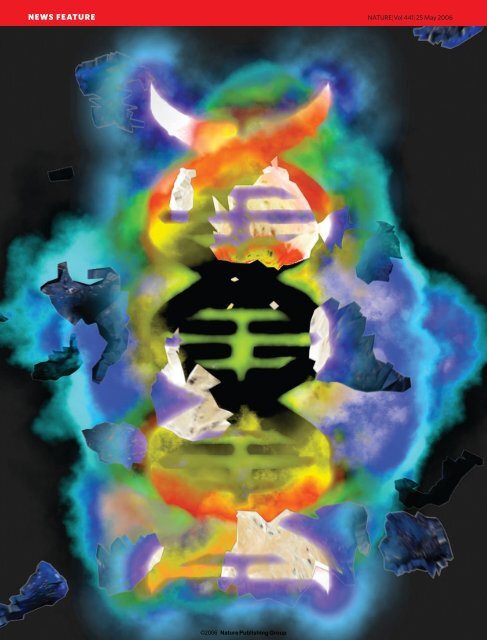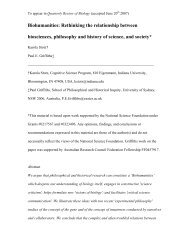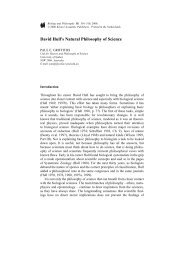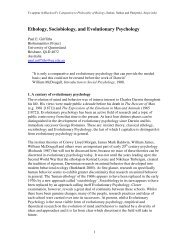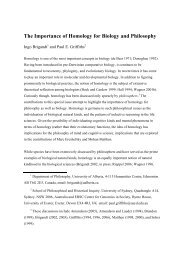What is a Gene? - Paul Griffiths
What is a Gene? - Paul Griffiths
What is a Gene? - Paul Griffiths
You also want an ePaper? Increase the reach of your titles
YUMPU automatically turns print PDFs into web optimized ePapers that Google loves.
NEWS FEATURE NATURE|Vol 441|25 May 2006<br />
©2006 Nature Publ<strong>is</strong>hing Group
NATURE|Vol 441|25 May 2006<br />
NEWS FEATURE<br />
C. DARKIN<br />
WHAT IS A GENE<br />
The idea of genes as beads on a DNA string <strong>is</strong> fast fading. Protein-coding sequences have no<br />
clear beginning or end and RNA <strong>is</strong> a key part of the information package, reports Helen Pearson.<br />
<strong>is</strong> not a typical four-letter<br />
word. It <strong>is</strong> not offensive. It <strong>is</strong> never<br />
bleeped out of TV shows. And<br />
‘<strong>Gene</strong>’<br />
where the meaning of most fourletter<br />
words <strong>is</strong> all too clear, that of gene <strong>is</strong> not.<br />
The more expert scient<strong>is</strong>ts become in molecular<br />
genetics, the less easy it <strong>is</strong> to be sure about<br />
what, if anything, a gene actually <strong>is</strong>.<br />
Rick Young, a genetic<strong>is</strong>t at the Whitehead<br />
Institute in Cambridge, Massachusetts, says<br />
that when he first started teaching as a young<br />
professor two decades ago, it took him about<br />
two hours to teach fresh-faced undergraduates<br />
what a gene was and the nuts and bolts of how<br />
it worked. Today, he and h<strong>is</strong> colleagues need<br />
three months of lectures to convey the concept<br />
of the gene, and that’s not because the students<br />
are any less bright. “It takes a whole semester<br />
to teach th<strong>is</strong> stuff to talented graduates,” Young<br />
says. “It used to be we could give a one-off definition<br />
and now it’s much more complicated.”<br />
In classical genetics, a gene was an abstract<br />
concept — a unit of inheritance that ferried a<br />
character<strong>is</strong>tic from parent to child. As biochem<strong>is</strong>try<br />
came into its own, those character<strong>is</strong>tics<br />
were associated with enzymes or proteins,<br />
one for each gene. And with the advent of molecular<br />
biology, genes became real, physical<br />
things — sequences of DNA which when converted<br />
into strands of so-called messenger<br />
RNA could be used as the bas<strong>is</strong> for building<br />
their associated protein piece by piece. The<br />
great coiled DNA molecules of the chromosomes<br />
were seen as long strings on which gene<br />
sequences sat like d<strong>is</strong>crete beads.<br />
Th<strong>is</strong> picture <strong>is</strong> still the working model for<br />
many scient<strong>is</strong>ts. But those at the forefront of<br />
genetic research see it as increasingly old-fashioned<br />
— a crude approximation that, at best,<br />
hides fascinating new complexities and, at<br />
worst, blinds its users to useful new paths<br />
of enquiry.<br />
Information, it seems, <strong>is</strong> parceled out along<br />
chromosomes in a much more complex way<br />
than was originally supposed. RNA molecules<br />
are not just passive conduits through which the<br />
gene’s message flows into the world but active<br />
regulators of cellular processes. In some cases,<br />
RNA may even pass information across generations<br />
— normally the sole preserve of DNA.<br />
An eye-opening study last year ra<strong>is</strong>ed the<br />
possibility that plants sometimes rewrite their<br />
DNA on the bas<strong>is</strong> of RNA messages inherited<br />
from generations past 1 . A study on page 469 of<br />
th<strong>is</strong> <strong>is</strong>sue suggests that a comparable phenomenon<br />
might occur in mice, and by implication<br />
in other mammals 2 . If th<strong>is</strong> type of phenomenon<br />
<strong>is</strong> indeed widespread, it “would have huge<br />
implications,” says evolutionary genetic<strong>is</strong>t<br />
Laurence Hurst at the University of Bath, UK.<br />
“All of that information seriously challenges<br />
our conventional definition of a gene,” says<br />
molecular biolog<strong>is</strong>t Bing Ren at the University<br />
of California, San Diego. And the information<br />
challenge <strong>is</strong> about to get even tougher. Later<br />
th<strong>is</strong> year, a glut of data will be released from<br />
the international Encyclopedia of DNA Elements<br />
(ENCODE) project. The pilot phase of<br />
ENCODE involves scrutinizing roughly 1% of<br />
the human genome in unprecedented detail;<br />
the aim <strong>is</strong> to find all the<br />
sequences that serve a useful<br />
purpose and explain what<br />
that purpose <strong>is</strong>. “When we<br />
started the ENCODE project<br />
I had a different view of<br />
what a gene was,” says contributing<br />
researcher Roderic<br />
Guigo at the Center for Genomic Regulation<br />
in Barcelona. “The degree of complexity we’ve<br />
seen was not anticipated.”<br />
Spools of DNA (above) still harbour surpr<strong>is</strong>es, with<br />
one protein-coding gene often overlapping the next.<br />
“We’ve come to the<br />
realization that the<br />
genome <strong>is</strong> full of<br />
overlapping transcripts.”<br />
— Phillip Kapranov<br />
Under fire<br />
The first of the complexities to challenge molecular<br />
biology’s paradigm of a single DNA<br />
sequence encoding a single protein was alternative<br />
splicing, d<strong>is</strong>covered in viruses in 1977 (see<br />
‘Hard to track’, overleaf). Most of the DNA<br />
sequences describing proteins in humans have a<br />
modular arrangement in which exons, which<br />
carry the instructions for making proteins, are<br />
interspersed with non-coding introns. In alternative<br />
splicing, the cell snips out introns and<br />
sews together the exons in various different<br />
orders, creating messages that can code for different<br />
proteins. Over the years genetic<strong>is</strong>ts have<br />
also documented overlapping genes, genes<br />
within genes and countless other weird arrangements<br />
(see ‘Muddling over genes’, overleaf).<br />
Alternative splicing, however, did not in itself<br />
require a drastic reappra<strong>is</strong>al of the notion of a<br />
gene; it just showed that some DNA sequences<br />
could describe more than one protein. Today’s<br />
assault on the gene concept <strong>is</strong> more far reaching,<br />
fuelled largely by studies that show the previously<br />
unimagined scope of RNA.<br />
The one gene, one protein idea <strong>is</strong> coming<br />
under particular assault from researchers who<br />
are comprehensively extracting and analysing<br />
the RNA messages, or transcripts, manufactured<br />
by genomes, including the human and<br />
mouse genome. Researchers led by Thomas<br />
Gingeras at the company Affymetrix in Santa<br />
Clara, California, for example, recently studied<br />
all the transcripts from ten chromosomes<br />
across eight human cell lines and worked out<br />
prec<strong>is</strong>ely where on the chromosomes<br />
each of the transcripts<br />
came from 3 .<br />
The picture these studies<br />
paint <strong>is</strong> one of<br />
mind-boggling complexity.<br />
Instead of d<strong>is</strong>crete genes<br />
dutifully mass-producing<br />
identical RNA transcripts, a teeming mass of<br />
transcription converts many segments of the<br />
genome into multiple RNA ribbons of differing<br />
lengths. These ribbons can be generated from<br />
both strands of DNA, rather than from just one<br />
as was conventionally thought. Some of these<br />
transcripts come from regions of DNA previously<br />
identified as holding protein-coding<br />
genes. But many do not. “It’s somewhat revolutionary,”<br />
says Gingeras’s colleague Phillip<br />
Kapranov. “We’ve come to the realization that<br />
the genome <strong>is</strong> full of overlapping transcripts.”<br />
Other studies, one by Guigo’s team 4 , and one<br />
by genetic<strong>is</strong>t Rotem Sorek 5 , now at Tel Aviv<br />
University, Israel, and h<strong>is</strong> colleagues, have<br />
hinted at the reasons behind the mass of transcription.<br />
The two teams investigated occasional<br />
reports that transcription can start at a<br />
DNA sequence associated with one protein<br />
and run straight through into the gene for a<br />
completely different protein, producing a<br />
fused transcript. By delving into databases of<br />
human RNA transcripts, Guigo’s team estimate<br />
that 4–5% of the DNA in regions conventionally<br />
recognized as genes <strong>is</strong> transcribed<br />
in th<strong>is</strong> way. Producing fused transcripts could<br />
be one way for a cell to generate a greater variety<br />
of proteins from a limited number of<br />
exons, the researchers say.<br />
Many scient<strong>is</strong>ts are now starting to think<br />
that the descriptions of proteins encoded in<br />
DNA know no borders — that each sequence<br />
reaches into the next and beyond. Th<strong>is</strong> idea<br />
will be one of the central points to emerge<br />
from the ENCODE project when its results are<br />
publ<strong>is</strong>hed later th<strong>is</strong> year.<br />
Kapranov and others say that they have documented<br />
many examples of transcripts in<br />
which protein-coding exons from one part of<br />
the genome combine with exons from another<br />
P. PLAILLY/SPL<br />
©2006 Nature Publ<strong>is</strong>hing Group<br />
399
NEWS FEATURE NATURE|Vol 441|25 May 2006<br />
ABBEY OF ST THOMAS, BRNO, CZECH REPUBLIC<br />
GRAPHIC SCIENCE/ALAMY<br />
TENNESSEE STATE LIB. & ARCHIVES/NLM/NIH<br />
Hard to track<br />
1860s After playing<br />
with pea plants,<br />
Austrian monk<br />
Gregor Mendel<br />
defines the basic<br />
rules of inheritance.<br />
Traits are<br />
determined by<br />
d<strong>is</strong>crete units that<br />
are passed from one<br />
generation to the next.<br />
1909 Dan<strong>is</strong>h botan<strong>is</strong>t Wilhelm Johanssen<br />
coins the word ‘gene’ for the unit associated<br />
with an inherited trait, although the physical<br />
bas<strong>is</strong> remains unknown.<br />
1910 Thomas<br />
Morgan’s work on<br />
fruitflies (right),<br />
shows that genes sit<br />
on chromosomes,<br />
leading to the idea<br />
of genes as beads<br />
on a string.<br />
1941 George Beadle<br />
and Edward Tatum introduce the concept that<br />
one gene makes one enzyme.<br />
1944 <strong>Gene</strong>s are made of DNA, find Oswald<br />
Avery (below), Colin MacLeod and Maclyn<br />
McCarty.<br />
1953 James Watson<br />
and Franc<strong>is</strong> Crick<br />
publ<strong>is</strong>h the chemical<br />
structure of DNA;<br />
the central dogma of<br />
molecular biology<br />
emerges in which<br />
information flows<br />
from DNA to RNA<br />
to protein.<br />
1977 Richard Roberts and Phillip Sharp<br />
d<strong>is</strong>cover that genes can be split into segments,<br />
leading to the idea that one gene can make<br />
several proteins.<br />
1993 The first microRNA <strong>is</strong> identified in the<br />
worm Caenorhabdit<strong>is</strong> elegans.<br />
2003<br />
<strong>Gene</strong>Sweep:<br />
Human<br />
genetic<strong>is</strong>ts<br />
come up with a<br />
definition for<br />
protein-coding<br />
genes in order to<br />
decide on a winner for a bet on the number of<br />
human genes. The winner <strong>is</strong> announced, but<br />
genetic<strong>is</strong>ts acknowledge that they don’t know<br />
the true answer.<br />
2006 The idea that human genes are one long<br />
continuum begins to emerge.<br />
400<br />
part that can be hundreds of thousands of<br />
bases away, with several other ‘genes’ in<br />
between. Th<strong>is</strong> continuum of genes might<br />
even spill over the boundaries of chromosomes:<br />
last year, Richard Flavell at Yale University<br />
School of Medicine in New Haven,<br />
Connecticut, documented human immunesystem<br />
genes that seem to be controlled by<br />
regulatory regions from another chromosome<br />
6 . “D<strong>is</strong>crete genes are starting to van<strong>is</strong>h,”<br />
Guigo says. “We have a continuum of<br />
transcripts.”<br />
Slippery concept<br />
The large transcriptional surveys suggest<br />
that a vast amount of the RNA manufactured<br />
by the mouse and human genomes do not<br />
code for proteins. Last year a consortium of<br />
researchers in Japan, for example, estimated<br />
that a whopping 63% of the mouse genome <strong>is</strong><br />
transcribed 7,8 ; only 1–2% of the genome <strong>is</strong><br />
thought to be spanned by sequences that<br />
contain everyday exons.<br />
The d<strong>is</strong>covery of RNA sequences that<br />
aren’t just intermediates between the DNA<br />
and the protein-making machinery <strong>is</strong> not<br />
new in itself; the cell’s protein-building apparatus<br />
requires a number of RNA molecules<br />
as well as proteins to operate. But the finding<br />
of ‘microRNAs’ and other RNA molecules<br />
now known to be vital in controlling many<br />
cellular processes in plants and animals, and<br />
the newly revealed ferment of RNA transcription,<br />
contributes to the view that RNA<br />
actively processes and carries out the<br />
instructions in the genome.<br />
Perhaps the regions that make non-coding<br />
RNA should also carry the status of genes, if<br />
not the name itself. “I think it’s time for people<br />
to take a deep breath<br />
and step back,” says molecular<br />
biolog<strong>is</strong>t John Mattick<br />
of the University of<br />
Queensland in Br<strong>is</strong>bane,<br />
Australia. “A lot of the<br />
information in the system <strong>is</strong> being transacted<br />
by RNA.”<br />
Although functions have been identified<br />
for several RNA molecules, the crux of the<br />
debate now <strong>is</strong> the extent to which all the<br />
extra RNA plays a part. It <strong>is</strong> conceivable that<br />
it <strong>is</strong> easier to overtranscribe and ignore the<br />
rubb<strong>is</strong>h than to invest in systems that produce<br />
only what <strong>is</strong> needed. A study from last<br />
year, however, hints that at least some of the<br />
mass of RNAs <strong>is</strong> doing something useful.<br />
Working at the Genomics Institute of the<br />
Novart<strong>is</strong> Research Foundation in San Diego,<br />
California, John Hogenesch and h<strong>is</strong> coworkers<br />
systematically quenched the activity<br />
of more than 500 non-coding RNAs in<br />
human cells and found that eight were<br />
involved in cell signalling and growth 9 .<br />
But Hogenesh, and many other scient<strong>is</strong>ts,<br />
remain convinced that non-coding RNAs<br />
are much less important, functionally, than<br />
those that describe proteins; in the past,<br />
©2006 Nature Publ<strong>is</strong>hing Group<br />
“A lot of the<br />
information <strong>is</strong> being<br />
transacted by RNA.”<br />
— John Mattick<br />
when scient<strong>is</strong>ts have searched for the genetic<br />
bas<strong>is</strong> of a d<strong>is</strong>ease or other character<strong>is</strong>tic they<br />
have overwhelmingly found the underlying<br />
mutation to be in a protein-coding gene<br />
rather than in another region. “The preponderance<br />
of evidence suggests that proteincoding<br />
genes will hold their own when the<br />
day <strong>is</strong> over,” Hogenesh says.<br />
Some of the recent d<strong>is</strong>coveries — that the<br />
human genome makes a continuum of transcripts<br />
and that cells produce masses of noncoding<br />
RNA molecules — have not posed<br />
much of a problem to people outside the<br />
world of molecular biology. Population<br />
genetic<strong>is</strong>ts can examine how a trait <strong>is</strong> passed<br />
down and evolves regardless of the prec<strong>is</strong>e<br />
molecular mechan<strong>is</strong>m that underlies it. For<br />
example, genetic<strong>is</strong>ts can build models showing<br />
how a mutation <strong>is</strong> inherited whether it<br />
affects a protein, a non-coding RNA or a regulatory<br />
region. “I don’t actually care if it’s<br />
making a protein or not,” says Hurst. “The<br />
equations are still the same.”<br />
But the same can’t be said for studies<br />
revealing so-called extragenomic modes of<br />
inheritance. In recent years, many investigators<br />
have focused on epigenetic inheritance,<br />
in which information <strong>is</strong> passed from parent<br />
to offspring independent of the DNA<br />
sequence. And th<strong>is</strong> week in Nature (see page<br />
469), Minoo Rassoulzadegan’s team at the<br />
French National Institute for Health and<br />
Medical Research (INSERM) in Nice, France,<br />
reports that RNA may sometimes be complicating<br />
traditional models of inheritance.<br />
In mice, mutations in the Kit gene cause<br />
white patches on the tail and feet; if a mouse<br />
has one normal Kit gene and one mutated<br />
one it will have the spots. The odd thing <strong>is</strong><br />
that some of the offspring of<br />
such mice, who inherit two<br />
normal Kit genes, still have the<br />
white tail. The French group<br />
suggest that the mutant Kit<br />
gene manufactures abnormal<br />
RNA molecules, which accumulate in sperm<br />
and pass into the egg. These bits of RNA<br />
somehow silence the normal Kit gene in the<br />
next generation and subsequent ones, producing<br />
the spotted-tail effect. “We are convinced<br />
that it’s a more general phenomenon,”<br />
says co-author Franço<strong>is</strong> Cuzin.<br />
If th<strong>is</strong> <strong>is</strong> strange, the work reported last<br />
year 1 on the cress plant Arabidops<strong>is</strong> by<br />
Robert Pruitt and h<strong>is</strong> colleagues at Purdue<br />
University in West Lafayette, Indiana, <strong>is</strong> even<br />
stranger. Here the gene involved <strong>is</strong> called<br />
HOTHEAD. Pruitt and h<strong>is</strong> co-workers’<br />
analys<strong>is</strong> shows that some plants do not carry<br />
the mutant version of HOTHEAD that their<br />
parents possessed. These plants had replaced<br />
the abnormal DNA sequence with the regular<br />
code possessed by earlier generations.<br />
“It’s like, whoa, th<strong>is</strong> changes everything,”<br />
Pruitt says. “It definitely changes my view of<br />
inheritance.”<br />
Pruitt <strong>is</strong> now working to explain how the
NATURE|Vol 441|25 May 2006<br />
NEWS FEATURE<br />
M. ALICE WEBB<br />
Back-up copies: mutant DNA in the cress plant may be ‘corrected’ by inherited RNA.<br />
plant could perform such a feat. One idea <strong>is</strong><br />
that they carry a back-up copy of their grandparents’<br />
genetic information encoded in RNA<br />
that <strong>is</strong> passed into seeds along with the regular<br />
DNA and <strong>is</strong> then used as a template to ‘correct’<br />
certain genes. Conceivably, Pruitt says, some<br />
of the mystery non-coding transcripts could<br />
be responsible. “I think there’s something<br />
being inherited outside what we think of as the<br />
conventional DNA genome.”<br />
Changing views<br />
The implications of such findings for our<br />
understanding of evolution have yet to be figured<br />
out. But research into the role of RNA as a<br />
carrier of information across generations<br />
Muddling over genes<br />
Science philosophers Karola<br />
Stotz, at Indiana University<br />
in Bloomington, and <strong>Paul</strong><br />
<strong>Griffiths</strong>, now at the<br />
University of Queensland in<br />
Australia, are attempting to<br />
measure the extent of<br />
working biolog<strong>is</strong>ts’<br />
bewilderment over genes.<br />
They collected together 14<br />
weird and wonderful (but<br />
real) genetic arrangements<br />
and asked biolog<strong>is</strong>ts to<br />
decide whether each<br />
represents one, or more<br />
than one, gene.<br />
One <strong>is</strong> a DNA segment<br />
that uses some of the same<br />
protein-coding sequences<br />
to manufacture two entirely<br />
different proteins with<br />
d<strong>is</strong>tinct functions. In another,<br />
one ‘gene’ <strong>is</strong> nestled within<br />
the non-protein coding<br />
intron of another. Another<br />
protein <strong>is</strong> assembled when<br />
four different RNA<br />
molecules, made from DNA<br />
scattered over 40,000 base<br />
pairs, are assembled into<br />
one transcript.<br />
Confused So were the<br />
500 biolog<strong>is</strong>ts who<br />
completed the questionnaire.<br />
Stotz and <strong>Griffiths</strong> found that<br />
60% are typically sure of one<br />
answer, and 40% are<br />
confident of another.<br />
Hardly any confess that<br />
they don’t know.<br />
Stotz wants to examine<br />
whether scient<strong>is</strong>ts working in<br />
separate d<strong>is</strong>ciplines tend to<br />
view the situations in<br />
different lights. “It will be<br />
interesting to know if there <strong>is</strong><br />
some order to the confusion,”<br />
Stotz says.<br />
H.P.<br />
©2006 Nature Publ<strong>is</strong>hing Group<br />
prom<strong>is</strong>es to enrich — and complicate — the<br />
notion of a gene yet further.<br />
Leaving aside the can of worms that studies<br />
on epigenetics are beginning to open up, does<br />
it matter that many scient<strong>is</strong>ts not directly concerned<br />
with molecular mechan<strong>is</strong>ms continue<br />
to think of genetics in simpler terms Some<br />
genetic<strong>is</strong>ts say yes. They worry that<br />
researchers working with an oversimpl<strong>is</strong>tic<br />
idea of the gene could d<strong>is</strong>card important<br />
results that don’t fit. A medical researcher, for<br />
example, might gloss over the many different<br />
transcripts generated by a sequence at one<br />
location. And the lack of a clear idea of what a<br />
gene <strong>is</strong> might also hinder collaboration. “I find<br />
it sometimes very difficult to tell what someone<br />
means when they talk about genes because<br />
we don’t share the same definition,” says developmental<br />
genetic<strong>is</strong>t William Gelbert of Harvard<br />
University in Cambridge, Massachusetts.<br />
Without a clear definition of a gene, life <strong>is</strong><br />
also difficult for bioinformaticians who want<br />
to use computer programs to spot landmark<br />
sequences in DNA that signal where one gene<br />
ends and the next begins. But reaching a consensus<br />
over the definition <strong>is</strong> virtually impossible,<br />
as Karen Eilbeck can attest. Eilbeck, who<br />
works at the University of California in Berkeley,<br />
<strong>is</strong> a coordinator of the Sequence Ontology<br />
consortium. Th<strong>is</strong> defines labels for landmarks<br />
within genetic-sequence databases of organ<strong>is</strong>ms,<br />
such as the mouse and fly, so that the<br />
databases can be more easily compared. The<br />
consortium tries, for example, to decide<br />
whether a protein-coding sequence should<br />
always include the triplet of DNA bases that<br />
mark its end.<br />
Eilbeck says that it took 25 scient<strong>is</strong>ts the better<br />
part of two days to reach a definition of a<br />
gene that they could all work with. “We had<br />
several meetings that went on for hours and<br />
everyone screamed at each other,” she says.<br />
The group finally settled on a loose definition<br />
that could accommodate everyone’s demands.<br />
(Since you ask: “A locatable region of genomic<br />
sequence, corresponding to a unit of inheritance,<br />
which <strong>is</strong> associated with regulatory<br />
regions, transcribed regions and/or other<br />
functional sequence regions.”)<br />
Rather than striving to reach a single definition<br />
— and coming to blows in the process —<br />
most genetic<strong>is</strong>ts are instead incorporating less<br />
ambiguous words into their vocabulary such<br />
as transcripts and exons. When it <strong>is</strong> used, the<br />
word ‘gene’ <strong>is</strong> frequently preceded by ‘proteincoding’<br />
or another descriptor. “We almost<br />
have to add an adjective every time we use that<br />
noun,” says Franc<strong>is</strong> Collins, director of the<br />
National Human Genome Research Institute<br />
at the National Institutes of Health in<br />
Bethesda, Maryland.<br />
But however much genetic<strong>is</strong>ts struggle to pin<br />
down the elusive gene, it <strong>is</strong> prec<strong>is</strong>ely its ambiguous<br />
nature that fuels their continued curiosity.<br />
“It’s ever more fascinating,” says Whitehead’s<br />
Young. Some things, it seems, are not best portrayed<br />
by a crude four-letter word.<br />
■<br />
Helen Pearson <strong>is</strong> a reporter working for Nature<br />
in New York.<br />
1. Lolle, S. J., Victor, J. L., Young, J. M. & Pruitt. R. E. Nature<br />
434, 505–509 (2005).<br />
2. Rassoulzadegan, M. et al. Nature 441, 469–474 (2006).<br />
3. Cheng J. et al. Science 308, 1149–1154 (2005).<br />
4. Parra, G. et al. Genome Res. 16, 37–44 (2006).<br />
5. Akiva, P. et al. Genome Res. 16, 30–36 (2006).<br />
6. Spilianak<strong>is</strong>, C. G., Lalioti, M. D., Town, T., Lee, G. R. & Flavell,<br />
R. A. Nature 435, 637–645 (2005).<br />
7. FANTOM Consortium and RIKEN Genome Exploration<br />
Research Group and Genome Science Group (Genome<br />
Network Project Core Group) Science 309, 1559–1563<br />
(2005).<br />
8. RIKEN Genome Exploration Research Group and Genome<br />
Science Group (Genome Network Project Core Group) and<br />
the FANTOM Consortium Science 309, 1564–1566<br />
(2005).<br />
9. Willingham, A. T. et al. Science 309, 1570–1573 (2005).<br />
401


